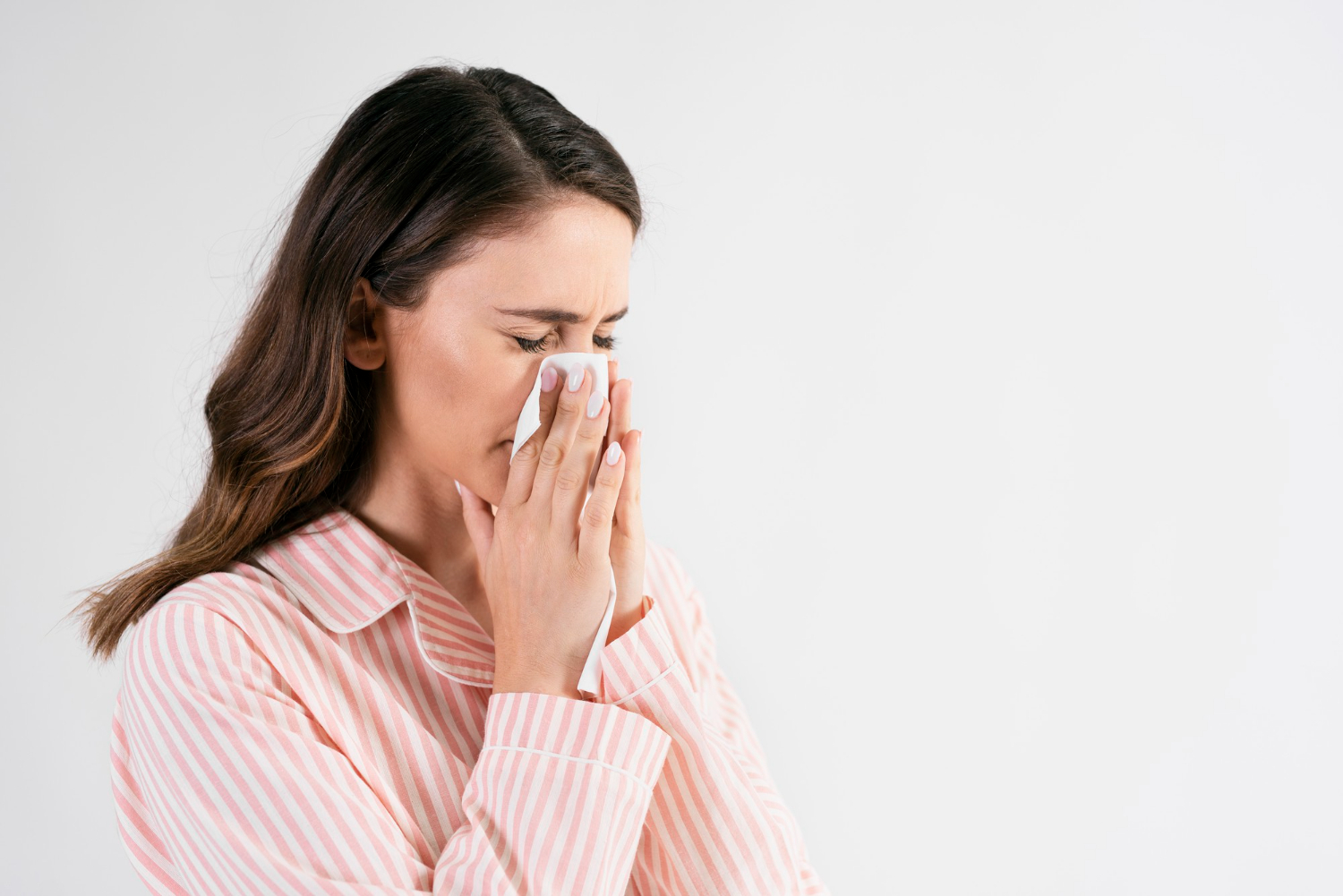Sneezing is one of the body’s most common reflexes, yet it often surprises us with its suddenness. It may seem simple, but sneezing is actually a complex response designed to protect the respiratory system from irritants. Whether caused by allergens, dust, or temperature changes, understanding why sneezing occurs helps manage symptoms and prevent more serious reactions.
Why Sneezing Occurs
Sneezing, medically known as sternutation, is a natural defense mechanism. It happens when the nasal lining detects irritants such as pollen, dust, smoke, or strong odors. These foreign particles trigger sensory nerves inside the nose, which send signals to the brain’s sneeze center in the medulla oblongata. This activates a reflex that causes a forceful expulsion of air through the mouth and nose to clear out irritants.
For instance, walking into a dusty room or spraying perfume may suddenly make you sneeze. In such cases, the nose reacts instantly to protect your airways. Sneezing can also result from infections like the common cold or flu, where the body attempts to expel viruses and mucus. According to CDC, respiratory droplets released during a sneeze can travel several feet, which is why covering your nose is crucial to prevent the spread of infections.
Sneezing is also influenced by changes in air pressure or cold temperature. When cold air enters your nasal passage, it causes the blood vessels to constrict, leading to irritation and triggering a sneeze reflex. This reaction is especially common in winter or when moving from warm to cold environments. People with nasal sensitivity may sneeze repeatedly in such conditions as their airways react to the sudden shift in air temperature.
How the Environment Triggers Sneezing
Your environment plays a huge role in determining how frequently you sneeze. Seasonal changes, pollution, or even humidity levels can influence nasal sensitivity. During spring, for example, pollen levels rise, causing allergic rhinitis or hay fever. The immune system mistakenly identifies harmless particles like pollen as threats and releases histamines that irritate the nasal passage, resulting in sneezing fits.
Indoor environments can be just as problematic. Mold, pet dander, and even household cleaning products may trigger sneezing in sensitive individuals. The U.S. Environmental Protection Agency (EPA) emphasizes the importance of maintaining clean indoor air and reducing exposure to potential allergens to minimize respiratory irritation. Learn more about air quality standards at the EPA website.
Even sudden temperature shifts — like stepping out of an air-conditioned room into hot air — can lead to a sneeze. This is known as a photic sneeze reflex, where changes in light or temperature stimulate nerve endings in the face and nose.
Symptoms: From Early Signs to Major Issues
Sneezing often starts as a mild irritation but can develop into a more serious concern if the underlying cause is not addressed.
Early Symptoms:
- Itchy or tickling sensation inside the nose
- Watery eyes or nasal discharge
- Occasional sneezing without congestion
Moderate Symptoms:
- Repeated sneezing in short intervals
- Blocked or runny nose
- Mild headache or throat irritation
Major Symptoms:
- Persistent sneezing lasting over a week
- Facial pressure or sinus pain
- Fever, indicating possible infection
If sneezing occurs alongside fatigue, nasal blockage, or breathing difficulty, it may point to chronic sinusitis or allergies requiring medical attention. Persistent episodes should be evaluated by an ear, nose, and throat (ENT) specialist or allergist. For guidance on allergy management, refer to resources from the Mayo Clinic.
What Happens in the Body During a Sneeze
Sneezing involves a series of rapid physical reactions that occur almost instantaneously. Once the brain detects irritation, it triggers the sneeze reflex arc:
- The diaphragm contracts to push air upward.
- Chest muscles tighten while the vocal cords briefly close.
- Pressure builds in the lungs, then releases forcefully as the cords open.
- Air — along with saliva and mucus — is expelled at speeds up to 100 mph.
During this reflex, many body systems synchronize — including the respiratory, muscular, and nervous systems. Interestingly, most people instinctively close their eyes while sneezing. This reflex prevents debris or germs from entering through the eyes and protects the optic nerves from sudden pressure changes.
In some individuals, particularly women, urine leakage during sneezing can occur due to a condition called stress urinary incontinence. The forceful abdominal pressure created during a sneeze puts stress on the bladder and pelvic muscles, leading to small leaks of urine. It is more common after childbirth or in people with weakened pelvic floor muscles. Regular pelvic floor exercises, such as Kegels, can help strengthen this area and reduce the risk.
Besides urine leakage, sneezing can occasionally cause other pressure-related effects, such as minor ear popping or temporary lightheadedness. This occurs because the same air pressure that forces mucus out also travels through the Eustachian tubes, briefly affecting the ears. Though harmless, repeated or violent sneezing may sometimes cause mild strain around the chest or rib area.
When to Be Concerned
Occasional sneezing is normal and harmless. However, if you experience frequent or uncontrollable sneezing, it could indicate allergies, sinus problems, or environmental irritants. In rare cases, excessive sneezing can cause nosebleeds or fatigue due to pressure on nasal tissues. Seeking timely medical advice ensures proper treatment and relief.
Final Thoughts
Sneezing is more than a simple reflex — it’s a natural defense mechanism protecting your respiratory health. By understanding its causes, environmental influences, and body reactions, you can manage triggers more effectively and maintain better overall wellness. Maintaining clean air, monitoring allergens, and supporting nasal hygiene are practical steps toward reducing unwanted sneezing episodes.

